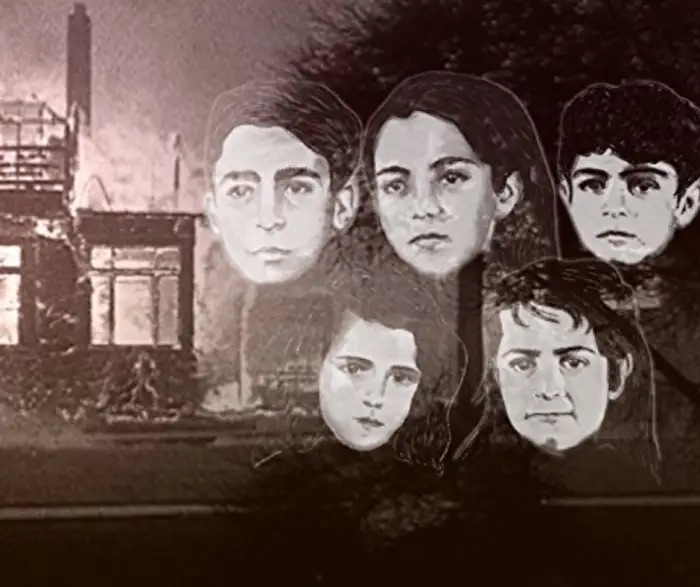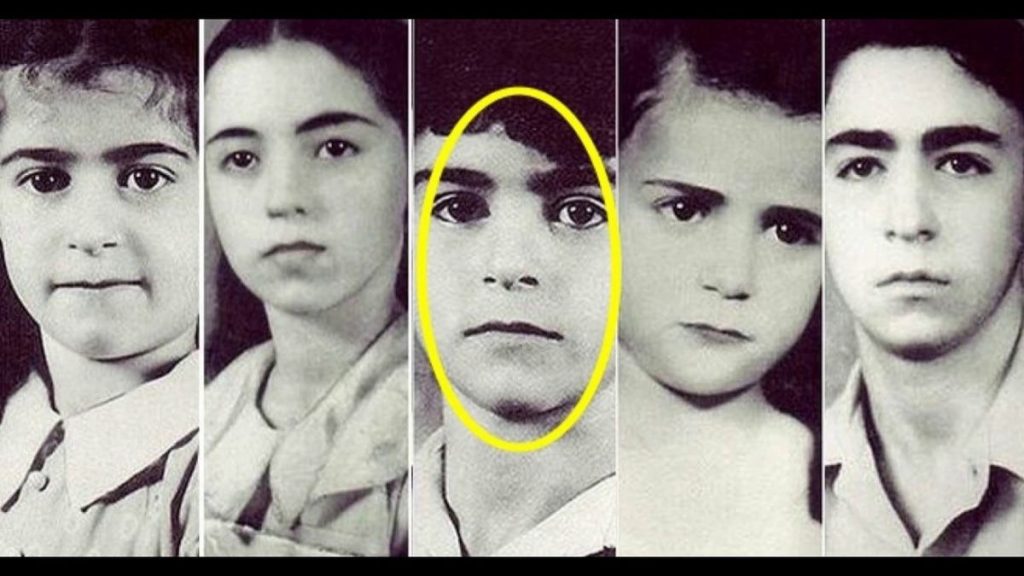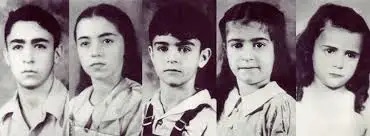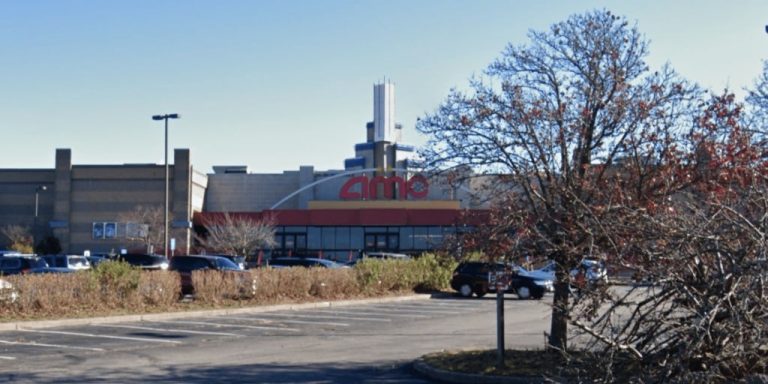On Christmas Eve in 1945, in Fayetteville, West Virginia, something tragic happened to George and Jennie Sodder and their children. They went to bed, but a fire broke out later that night. While George, Jennie, and four of their children were able to escape, the other five children have not been seen or heard from since that fateful evening. It’s a heartbreaking and mysterious story.

For nearly 40 years, there was a large billboard on Route 19 near Fayetteville. It displayed images of the five Sodder children: Maurice, 14; Martha, 12; Louis, 9; Jennie, 8; and Betty, 5. Right below their names and ages, there was a paragraph that depicted possible scenarios of what might have happened to them. It must have been a somber and thought-provoking sight for anyone who passed by.
The story of George Sodder’s journey to the United States and his subsequent success and prosperity.
George Sodder, originally named Giorgio Soddu, was born in Tula, Sardinia in 1895. At the age of 13 in 1908, he embarked on a journey to the United States. Accompanied by his older brother, they arrived at Ellis Island. However, his brother decided to return to Italy, leaving George to fend for himself. Despite the challenges, George’s determination led him to find work on the Pennsylvania railroads. He took on the role of carrying water and supplies to rail laborers, displaying his resourcefulness and eagerness to work.
After arriving at Ellis Island, George eventually made his way to Smithers, West Virginia, where he worked as a driver. With his intelligence, strong work ethic, and entrepreneurial spirit, he eventually started his own trucking company. It was during one of his visits to a local store called the Music Box that he met Jennie Cipriani, the daughter of the store’s owner. They fell in love, got married, and went on to have 10 children.
They decided to settle in Fayetteville, West Virginia, attracted by its small-town atmosphere and the presence of a vibrant Italian immigrant community. The Sodders became a well-respected family, and George, known for his lively and friendly nature, was liked by everyone he met. Interestingly, George never spoke about his past or the reasons behind his decision to leave Italy.

The Full Account of the Memorable Christmas Eve That Changed Everything
George Sodder tried his best to save his children. When he, his wife, and some of the kids got out of the house, George bravely went back inside to rescue the others. But things got intense when he accidentally cut his arm while trying to make his way back in.
The house was filled with thick smoke and fire, making it impossible for George to see anything inside. He knew that Sylvia (who was 2 years old), George Jr. (16 years old), Marion (17 years old), and John (23 years old) were safe outside with his wife. However, he assumed that the rest of the children were still upstairs.
Unfortunately, the flames had spread throughout most of the downstairs area, and the staircase was completely engulfed in fire. This meant that George couldn’t reach the children that way. So, he quickly raced back outside, thinking that he could reach them through the upstairs windows.
At the Sodder house, there was usually a ladder outside that was always there. But on that fateful Christmas Eve, George noticed that the ladder was mysteriously missing. It must have been such a shock amidst the already unimaginable disaster.
George’s next idea was to bring one of his trucks up to the house and climb on top of it to reach the windows and rescue his kids. However, when he went to his truck, to his surprise, it wouldn’t start. Talk about bad luck! Luckily, he had another truck, so he gave that one a try. But unfortunately, it didn’t work either, even though both trucks had been running perfectly fine before this happened.
At this point, George Sodder must have been incredibly frustrated and desperate, trying to come up with any possible way to save his five children. It was such a difficult situation for him.
Marion Sodder quickly rushed to a neighbor’s house to call the fire department, but unfortunately, she didn’t receive a response from the operator. Another neighbor, who happened to be at a local pub, noticed the raging fire and tried to make an emergency call, but strangely enough, no operator answered despite repeated attempts. As the Sodders helplessly watched their house burn and desperately tried to save their children, the neighbor drove into town and sought help from Fire Chief F.J. Morris.
Chief Morris initiated a “phone tree” system, where one firefighter called another, and so on, to alert the fire crew. Despite the fire department being just a couple of hours away, they didn’t arrive until 8 a.m. Sadly, by the time they got there, the Sodder home had been reduced to nothing but smoldering ashes.
George and Jennie believed that their five children had perished in the fire. However, a thorough search of the grounds yielded no trace of human remains. Chief Morris initially speculated that the intense fire had completely cremated the bodies of the Sodder children.
A state police inspector examined the debris and concluded that the fire had been caused by faulty wiring. George Sodder decided to transform the home into a memorial for his children, symbolically covering the basement with five feet of earth. Approximately one week later, the coroner issued five death certificates, officially attributing the cause of death for each of the Sodder children to “fire of suffocation.” But as you mentioned, there is much more to this story…
The Sodders’ journey to recover from their unimaginable tragedy was accompanied by a series of peculiar incidents that caught their attention prior to the fire. Several months before the devastating event, an unfamiliar individual arrived at their home, inquiring about employment. This person proceeded to the rear of the house, where they pointed out two fuse boxes and ominously stated, “This will eventually lead to a fire.” Adding to the strangeness, George had recently had the wiring inspected, and it had been deemed to be in excellent working condition.
Additionally, an insurance agent approached the family, attempting to sell them life insurance. George’s refusal seemed to greatly upset the agent. However, what truly stood out was the statement the agent made before departing. He exclaimed, “Your house will go up in flames, and your children will be destroyed. You will pay for the derogatory comments you have made about Mussolini.” It was widely known that George held strong negative views towards the Italian dictator and had engaged in heated arguments with other Italian community members in Fayetteville. At the time, George did not pay much attention to the man’s threats.
The older Sodder boys actually mentioned something pretty strange. Right before Christmas, they spotted a man they had never seen before parked along U.S. Highway 21. This guy seemed really focused on watching the younger kids as they were coming home from school.
Then, in the middle of the night on Christmas morning, the phone suddenly rang inside the Sodder house, breaking the silence. Jennie picked up the phone, but it turned out to be a wrong number. As she headed back to bed, she noticed that all the lights downstairs were on, the curtains were open, and the front door was unlocked. Marion was snoozing on the sofa, and Jennie figured the rest of the kids were still upstairs, fast asleep in their beds. She closed up the house and went back to bed herself, but just before she dozed off, she heard a loud thud on the roof, followed by a rolling sound. The next time she woke up, the house was filled with smoke and engulfed in flames.
Jennie Sodder just couldn’t wrap her head around how there was no trace of the five bodies. She saw remnants of the fire that were still recognizable, so it didn’t make sense that the children would leave absolutely nothing behind. She even talked to someone who worked at a crematorium, and they said that even after being burned for two hours at 2,000 degrees, bones would still remain. But their house turned to ash in just 45 minutes.
And the strange events just kept piling up. A telephone repairman told the Sodders that their phone lines had been cut, not burned. They also thought about the fact that if it was an electrical fire, the power should have been out, so how were the downstairs lights still working?
Then, a witness came forward and said they saw a man at the fire scene taking away equipment used for removing car engines. That might explain why neither of George’s cars would start that night. And when Sylvia Sodder visited the fire site, she found a hard rubber object in the yard. George remembered the loud thud his wife heard on the roof that night, and he thought it could have been a napalm “pineapple bomb.
There was a woman who came forward and claimed to have witnessed the missing children in a passing car during the fire. Additionally, another woman stated that she served them breakfast the morning after the fire at a restaurant approximately 50 miles west of Fayetteville. She even mentioned that the car they left in had Florida license plates.
Furthermore, a woman at a hotel in Charleston recognized the children from a newspaper article. She reported seeing four of them a week after the fire, accompanied by two women and two men of Italian descent. She tried to engage with the children, but the men reacted hostilely whenever she approached them.
Despite these compelling witness reports, the local officials inexplicably declined to initiate an investigation.
Two years later, George and Jennie reached out to the FBI, hoping for their assistance. However, they received a response from J. Edgar Hoover himself, declining to provide the Sodders with the services of the FBI. Hoover cited that the case was beyond their jurisdiction. Instead, he redirected them to the local Fayetteville authorities. Unfortunately, both the local police and fire department refused to participate.
In their relentless pursuit of answers, the Sodders decided to enlist the help of a private investigator named C.C. Tinsley. Through Tinsley’s investigation, a shocking revelation came to light. It was discovered that the insurance salesman who had been harassing George earlier was actually a member of the coroner’s jury that had deemed the fire an accident.
Tinsley discovered during his investigation! He came across a peculiar story from a local minister who claimed that Chief F.J. Morris had confided in him about finding a heart at the fire scene. Morris supposedly hid the heart in a box and buried it there.
After Tinsley urged Morris to retrieve the box, they took it to a funeral director who determined that it was actually beef liver, completely unaffected by the fire. Can you imagine? Following this revelation, rumors started circulating that the fire chief purposely buried the beef liver in the ashes, hoping that the discovery of any remains would discourage further investigation.
In the late summer of 1949, the Sodders decided to take matters into their own hands and hired a pathologist named Oscar B. Hunter. They excavated the site and unearthed several small pieces of vertebrae. Hunter sent these bones to the Smithsonian Institution, which concluded that they were human bones belonging to a single individual of an unknown age, estimated to be between 14 and 22.
The vertebrae they found displayed no evidence of exposure to the fire. The report noted the peculiarity of not finding any other bones, considering that a fire lasting only 45 minutes should have left behind the skeletons of all five individuals. It was at this juncture that George and Jennie decided to erect a billboard, offering a $5,000 reward, which eventually increased to $10,000.
The Sodder Children Billboard



Photograph Addressed to Jennie Sodder
Without a doubt, the reward and the billboard generated numerous alleged sightings of the Sodder children. George diligently followed up on the most compelling leads, but regrettably, he always returned empty-handed, leaving Jennie disappointed. Then, in 1968, over two decades after the tragic fire, Jennie received an envelope addressed solely to her. The postmark indicated that it originated from Kentucky, yet it lacked a return address. Enclosed within the envelope was a photograph portraying a young man in his mid-20s. On the reverse side of the picture, a cryptic message was inscribed, stating, “Louis Sodder. I love brother Frankie. Ilil Boys. A90132 or 35.”
George and Jennie were deeply moved by the uncanny resemblance between the man in the photograph and their son, Louis. From the dark, curly hair and dark brown eyes to the matching nose and the upward tilt of the left eyebrow, the similarities were striking. Filled with renewed hope, they engaged the services of yet another private investigator and dispatched them to Kentucky. Unfortunately, they never received any further communication from the investigator, leaving this turn of events shrouded in mystery.
The Sodders were deeply concerned about the potential harm that could come to their son if they made the letter public or disclosed the town mentioned in the postmark. As a result, they chose not to reveal this information. Instead, they made modifications to the billboard, incorporating an updated image that they believed depicted Louis. Additionally, they displayed the same image prominently over their fireplace. This served as a way for them to maintain hope and pay tribute to their missing son.
A Father’s Plea, a Mother’s Grief, and a Tragic Ending
George expressed in an interview that their time was running out and their only desire was to find out the truth. If their children did indeed perish in the fire, they wanted to be convinced of it. However, if they were still alive, they wanted to uncover what had truly happened to them. Sadly, George Sodder passed away one year later.
Following this, Jennie had a fence built around her property and began adding rooms to the house. Some suggest that these additional rooms created a sense of seclusion between her and the outside world. Since the night of the fire, Jennie wore black as a symbol of mourning, and she continued to do so until her death in 1989. In that same year, after four decades, the billboard was finally taken down.
Despite their relentless efforts, no concrete evidence has been uncovered thus far. They have theorized that the local mafia may have attempted to recruit George, and when he declined, someone known to the children was enlisted to kidnap them. This individual allegedly informed the children about the fire and offered to ensure their safety. If the children did indeed survive the fire, it is believed that they refrained from contacting their parents out of concern for their parents’ lives.
At present, Sylvia Sodder, the youngest of the Sodder children, is 72 years old. Her earliest recollection revolves around the distressing image of her father, covered in blood, as he valiantly attempted to rescue his children amidst the chaos. Sylvia remains steadfast in her belief that her siblings did not perish in the fire and continues to actively search for any clues that may shed light on their perplexing disappearance.






















+ There are no comments
Add yours